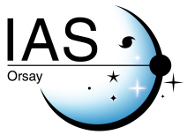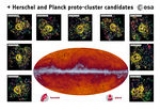Enigmatic high-redshift galaxies discovered by Planck and Herschel
Many new and enigmatic high redshift galaxies that are intensively forming stars have been discovered using ESA’s Planck and Herschel satellites . These galaxies occur in clumps – and could be the long-sought formation phase of galaxy clusters. Some appear very bright, and have been found to be gravitationally lensed galaxies. These rapidly star-forming galaxies could help solve a central problem in cosmology: how did the large scale structure of galaxies form?
From the standpoint of galaxy evolution, studying the intense star-formation epoch in massive dark-matter halos will provide a wealth of information on the kinematics and evolutionary history of galaxies in massive galaxy clusters. For cosmology, galaxy clusters tell us about the baryon content of the Universe, the role of dark matter in the assembly of large scale structure, and provides insights into possible deviations from our simple, Gaussian, model of the early universe. This means that the search for distant galaxy clusters and/or galaxies amplified by gravitational lensing is a very hot topic. ESA’s Planck satellite can find these rare objects over the entire sky, while ESA’s Herschel space observatory can scrutinize them in fine detail.
The Planck satellite has provided astronomers with the first all-sky submillimetre (sub-mm) survey sensitive enough to find the rarest, most luminous high−redshift sub-mm sources. These appear bright either as a result of strong gravitational lensing, or because they represent the combined far-infrared (FIR)/sub−mm emission from multiple intense starbursts in a young galaxy cluster – the most massive and rapidly collapsing dark−matter environments in the early Universe. When Planck scientists started looking for these poorly understood sources, they were surprised to find so many candidates. To confirm the nature of these objects, though, more detailed observations were needed. For this, they were awarded exceptional “must-do” observing time on the Herschel Space Observatory to study 200 of these sources. The results were surprising.
“We were immediately shocked by the large fluxes or angular concentrations of these galaxies. Finding so many intensively star forming, dusty galaxies in such small groups was a huge surprise. We think this is a missing piece of cosmological structure formation: intensely star-forming groups of galaxies at high redshift, which are the precursors of today’s largest galaxy clusters” says Pr. Hervé Dole (IAS, Orsay) who leads the analysis.
“Most of the targets were found in the Planck data using a dedicated method looking at tiny fluctuations in the maps. These indicated the presence of high-redshift galaxies” says Dr Ludovic Montier (IRAP, Toulouse) who developed the approach. Dr Mattia Negrello (INAF) adds that “a few other targets came from the Planck Catalogue of Compact Sources”. “These two selection methods, using maps or catalogs, apply similar principles of colour selection favouring the detection of the most distant galaxies” concludes Dole.
“The high sensitivity and angular resolution of Herschel allowed us to determine the nature of the Planck high-redshift candidates“ explains David Guéry (IAS) PhD student in charge of the analysis of the Herschel data; “The Herschel images show us either a single bright galaxy, suggesting that it is gravitationally lensed, or concentrations of many dusty galaxies, indicating a galaxy cluster.”
Dr Nicole Nesvadba (IAS) adds that “our targets are some of the brightest galaxies ever detected through gravitational lensing”.
“We are still a long way from fully understanding this new population,” says Clément Martinache (IAS, PhD student in charge of the near-infrared followup programme. “Our first near-infrared observations of some of the high-z candidates show unambiguous signs of galaxy clustering.”
“This program perfectly highlights the synergy between Planck and Herschel” says Pr Douglas Scott (UBC, Vancouver). “Planck selects the most interesting targets over the whole sky, and Herschel focuses on these spots for a refined analysis.” This means that the unique aspect of each space mission is used.
“Planck is a great experiment focused towards Cosmic Microwave Background cosmology, but it also allows major breakthroughs in other fields”, explains Dr Jean-Loup Puget (ESA), the Planck HFI Principal Investigator. “This has been shown recently with Galactic magnetic fields or polarized dust, and here we see it again for large-scale structure formation and high redshift galaxies.”
Dr Bruno Altieri (ESA), adds “Herschel has already discovered many high-redshift galaxies in deep surveys. These results from Planck open a new window with very bright, lensed galaxies and star-forming cluster candidates.”
“More observations are needed,” comments Dr David L. Clements (IC, UK), “and theorists have to work out the implications, but this huge new catalog of distant galaxies and clusters is the essential first step. There are going to be lots of exciting new results!”
Pr Dole concludes “Although the data were taken a few years ago, when Planck and Herschel were operating, we’re only at the start of this project, with many exciting targets being followed up using other observatories. The impressive synergy we see here between the major European space missions Planck and Herschel, was only possible because of the many colleagues working worldwide for years on this project, and thanks to the broader Planck and Herschel science teams. This is a fantastic effort, and more impressive results are expected in the coming months. And, at the same time, we’re preparing for the future with Euclid, the next ESA mission for cosmology.”
[[{"type":"media","view_mode":"media_responsive","fid":"320","attributes":{"alt":"","class":"media-image","height":"710","typeof":"foaf:Image","width":"1024"}}]]
Figure. The Planck all-sky observed at 545 GHz (bottom), with black dots indicating the location of our high-redshift candidates, observed by Herschel. The images around show Herschel/SPIRE observations, where contours represent the galaxy density.. Dole, Guéry, Hurier, ESA, Planck Collab., HFI consotrium, IAS, CNES, Univ. Paris-Sud, CNRS
Note
The article, in press in Astronomy and Astrophysics, is entitled: High-redshift infrared galaxy overdensity candidates and lensed sources discovered by Planck and confirmed by Herschel-SPIRE, and is authored by the Planck Collaboration. It has been supported by CNRS, CNES, Région Ile-de-France, and ANR.
Link ESA http://www.esa.int/Our_Activities/Space_Science/Herschel_and_Planck_find...
Link NASA http://www.nasa.gov/jpl/herschel/planck/a-gold-mine-of-galaxy-nuggets/
Link INSU http://www.insu.cnrs.fr/node/5251
Link A&A http://www.aanda.org/2015-press-releases/1095
About Planck
Launched in 2009, Planck was designed to map the sky at nine wavelengths (or frequencies) using two state-of-the-art instruments: the Low Frequency Instrument, which includes the frequency bands 30–70 GHz (1cm to 4mm); and the High Frequency Instrument, which includes the frequency bands 100–857 GHz (3mm to 350μm). HFI completed its survey in January 2012, while LFI continued to make science observations until October 2013.
Planck’s first all-sky image was released in 2010 and the first scientific data followed in 2011. The first image of the CMB came out in March 2013. Polarization and cosmology results were released in 2015.
The Planck Scientific Collaboration consists of all the scientists who have contributed to the development of the mission, and who participate in the scientific exploitation of the data during the proprietary period. These scientists are members of one or more of four consortia: the LFI Consortium, the HFI Consortium, the DK-Planck Consortium, and ESA’s Planck Science Office. The two European-led Planck Data Processing Centres are located in Paris, France and Trieste, Italy. The LFI consortium is led by N. Mandolesi, Agenzia Spaziale Italiana ASI, Italy (deputy PI: M. Bersanelli, Universita’ degli Studi di Milano, Italy), and was responsible for the development and operation of LFI. The HFI consortium is led by J.L. Puget, Institut d’Astrophysique Spatiale in Orsay, France (deputy PI: F. Bouchet, Institut d’Astrophysique de Paris, France), and was responsible for the development and operation of HFI. CNES is supporting HFI, the DPC and exploitation.
More information: http://www.cosmos.esa.int/web/planck and http://public.planck.fr/
About Herschel
Herschel, ESA’s cutting-edge space observatory, carried the largest, most powerful infrared telescope ever flown in space. The first observatory to cover the entire range from far-infrared to submillimetre wavelengths and bridge the two, Herschel explored further into the far-infrared than any previous mission, studying otherwise invisible dusty and cold regions of the cosmos, both near and far.
By tapping these unexploited wavelengths, Herschel was able to see phenomena beyond the reach of other observatories, and to study others at a level of detail that has not been captured before. The telescope’s primary mirror is 3.5 m in diameter, more than four times larger than any previous infrared space telescope and almost one and a half times larger than that of the Hubble Space Telescope. Its size has allowed Herschel to collect almost 20 times more light than any previous infrared space telescope.
The spacecraft carried three advanced science instruments: two cameras and a very high-resolution spectrometer. The detectors in these instruments were cooled to temperatures close to absolute zero by a sophisticated cryogenic system.
More information: https://www.esa.int/Science_Exploration/Space_Science/Herschel and http://www.herschel.fr
Contact Hervé Dole




